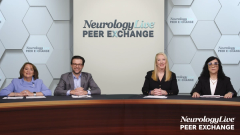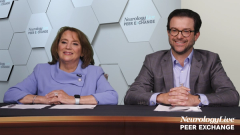
Natalizumab Biosimilar in Development in Multiple Sclerosis
Amy Perrin Ross, APN, Patricia Melville, NP-C, Aliza Ben-Zacharia, PhD, DNP, ANP-BC, and John Kramer, PA-C discuss natalizumab biosimilar (biosim-NTZ) PB006 phase 3 Antelope study.
Episodes in this series

Amy Perrin Ross, APN, MSN, CNRN, MSCN: We’ll switch gears a little bit and ask Pat to talk about which biosimilars are currently in development for MS [multiple sclerosis].
Patricia Melville, RN, NP-C, CCRC, MSCN: There’s currently a biosimilar that’s being looked at for natalizumab [Tysabri]. It’s been looked at in animal studies and there have been no biological differences. There is also an Antelope trial [NCT04115488] that has been published. This was an interchangeability study, which we had spoken about a little bit earlier. I think we’re going to hear more about the Antelope trial in a few moments. Just as a brief overview, this was a 48-week study. It was phase 3. It was [a] randomized, parallel arm, and double-blind study. It was conducted from 2019 to 2021. It was done at 48 MS centers in 7 different countries. So, a global study. As we spoke about before with these interchangeability studies, it was a 48-week study. So, at week 24, it was a one-to-one randomization. Half of the patients took the reference natalizumab, the other half took the biosimilar natalizumab. At week 24, the reference natalizumab switched over to the biosimilar and then they were followed for another 20 weeks. There were no differences found in terms of MRI outcome measures, secondary efficacy measures, tolerability, safety, or immunogenicity. There also is currently a biosimilar to rituximab [Rituxan]. Now, rituximab is an anti-CD20 monoclonal antibody, but this is used off-label in patients with multiple sclerosis and neuromyelitis optica spectrum disorder. There is a biosimilar that is available currently for that.
Amy Perrin Ross, APN, MSN, CNRN, MSCN: You bring up a good point about the biosimilar for rituximab. In addition to MS, I have a couple of patients in our practice who have other autoimmune disorders. One of them has been on rituximab for a number of years, and we were encouraged to switch her to the biosimilar. That was my first experience with the biosimilar steering headlights. This is not something I use all that commonly because we don’t generally use it in MS. But it was interesting because it was our neurobiologist who talked about her experience with biosimilars in oncology and her encouragement to go ahead and try this biosimilar on this patient. So, we did, and things have gone quite well. I’m being asked to use the biosimilar. And again, probably some of this preparation for the discussion today would have been helpful before then. But again, I think we as clinicians in MS are quite used to pulling our resources together and reaching out to people like neurooncologists or rheumatologists to get their take on what their experience has been. So far, in my thoughts, it’s looking pretty similar. John, do you want to talk a little bit more about the Antelope trial, perhaps?
John Kramer, PA-C: Sure. So the biosimilar natalizumab, also known as biosim-NTZ PB006, is the first biosimilar monoclonal antibody therapy specifically developed for MS treatment. There was a recent publication, a Hemmer et al [NCT04115488], just from this year that went through the trial in detail, but just from a top-line study design discussion, this was an international phase 3 parallel-group, randomized, active, controlled study that screened 531 patients with relapsing forms of MS, aged 18 to 60 years old [and] 266 of those patients were excluded. That means about half of all the patients that were screened were enrolled into the Antelope trial. The eligibility criteria will look similar to previous MS therapeutic drug trials that we have reviewed in the past.
The eligibility criteria included one or more documented relapse within the previous year, and patients had to have either one or more gadolinium-enhancing lesions seen on T1 weighted images, or 9 or more T2 weighted lesions seen on MRI scan of the brain. The Kurtzke EDSS [Expanded Disability Status Scale] score had to be between zero and 5, and the JC virus antibody index had to be equal to or less than 1.5. From an interventional standpoint, this product was infused every 4 weeks, and patients received biosim [biosimilar] natalizumab, 300 mg, or the reference molecule natalizumab, 300 mg from weeks zero to 44. As Pat has already mentioned, at week 24, the reference natalizumab group was re-randomized and 30 patients were switched to biosim [biosimilar] natalizumab for the remainder of the study.
On the left side of the slide, the primary end point was the cumulative number of new active lesions on MRI over 24 weeks. The key secondary end point was further MRI parameters, annualized relapse rate, and the EDSS score. Adverse events, laboratory evaluations, anti-JC virus antibodies, and anti-natalizumab antibodies were also studied. And on the right side of the slide, you see the results. So, again, remembering that there were 264 participants that were enrolled, which I would say would be a typical relapsing MS cohort. Basically, a 2 to 1 female randomization, average age around 37 years old. They were, again, split into 2 groups, treat with biosim [biosimilar] natalizumab, 131 patients, or the reference product natalizumab, 133 patients. The mean difference in the cumulative number of new active lesions, which again was the primary end point at week 24, was 0.17 between the biosim [biosimilar] natalizumab and reference natalizumab groups. And importantly, there was no significant differences between the treatment groups across secondary efficacy end points, safety, tolerability, or immunogenicity assessments.
Amy Perrin Ross, APN, MSN, CNRN, MSCN: Great. Thanks for that. Quite comprehensive overview of the Antelope trial, John. I think it’s important for us to think about what the study showed regarding the associated risks, switching from the reference natalizumab to the biosimilar natalizumab. Pat, do you think you could comment on that?
Patricia Melville, RN, NP-C, CCRC, MSCN: So really to just re-echo what John told us, there were really no significant differences in the group that took the biosim [biosimilar] natalizumab versus the reference natalizumab, versus the group that were switched from reference natalizumab to biosimilar natalizumab. This was observed across all the clinical outcomes that you mentioned. The overall adverse event profile was similar with there were no new or increased risks identified.
Amy Perrin Ross, APN, MSN, CNRN, MSCN: Great. Aliza, do you have any thoughts on that about the switching back and forth?
Aliza Ben-Zacharia, PhD, DNP, RN, ANP-BC, FAAN: I think it’s a great design of the study that you can switch back and forth and really inform clinicians about the data [on] efficacy, safety, and immunogenicity as you go back and forth. I think it’s a neat design that you can think about and comparing patients at different time points. Because when you go back and forth, it’s different time. We know that MS, it’s a dynamic disease and progressive disease. So doing that interchangeability studies as Pat, and I think John as well mentioned, I think it’s important for us as clinician to do that. I think as we go on and think about other comparison between biosimilar and biologic, it’s really important.
Transcript Edited for Clarity
Newsletter
Keep your finger on the pulse of neurology—subscribe to NeurologyLive for expert interviews, new data, and breakthrough treatment updates.































